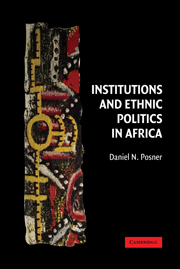Book contents
- Frontmatter
- Contents
- Preface
- INSTITUTIONS AND ETHNIC POLITICS IN AFRICA
- 1 Introduction
- I Introduction to Part I
- 2 Accounting for Zambia's Ethnic Cleavage Structure I
- 3 Accounting for Zambia's Ethnic Cleavage Structure II
- II Introduction to Part II
- III Introduction to Part III
- IV Introduction to Part IV
- Appendices
- Bibliography
- Index
- Titles in the series
2 - Accounting for Zambia's Ethnic Cleavage Structure I
The Emergence of Tribal Identities in Colonial Northern Rhodesia
Published online by Cambridge University Press: 05 June 2012
- Frontmatter
- Contents
- Preface
- INSTITUTIONS AND ETHNIC POLITICS IN AFRICA
- 1 Introduction
- I Introduction to Part I
- 2 Accounting for Zambia's Ethnic Cleavage Structure I
- 3 Accounting for Zambia's Ethnic Cleavage Structure II
- II Introduction to Part II
- III Introduction to Part III
- IV Introduction to Part IV
- Appendices
- Bibliography
- Index
- Titles in the series
Summary
In this chapter, I explain why, when contemporary Zambians think about who they are, and about who is and is not a member of their ethnic group, one of the ways they do so is as members of one of the country's six dozen tribes. I begin by showing how the institutions of Northern Rhodesian colonial rule created incentives for rural Africans to invest in their identities as tribe members. Then I account for the perpetuation (and reinforcement) of these identities among urban migrants. I conclude by explaining how the landscape of tribal divisions came to have its present contours.
THE ORIGINS OF TRIBAL IDENTITIES IN RURAL ZAMBIA
The British South Africa Company (BSA Co.) took over the administration of the territory that later became Zambia in 1894. The company sought to administer the territory with two goals in mind. First, it sought to extract labor from the local population to sustain its mining efforts and satisfy the demands of its white settler population for African workers. Second, it sought to minimize its costs. Taxation was embraced from the beginning as the key vehicle for achieving both of these goals. It not only generated revenue but, because taxes were payable in cash only, it also induced large numbers of African men to take up wage employment for Europeans. First imposed in the northeastern part of the territory in 1900 and in the northwestern part in 1904, taxation quickly became “the heart and soul of Company government in Northern Rhodesia, and the constant preoccupation of district officials” (Coombe 1968: 12).
- Type
- Chapter
- Information
- Institutions and Ethnic Politics in Africa , pp. 26 - 55Publisher: Cambridge University PressPrint publication year: 2005

